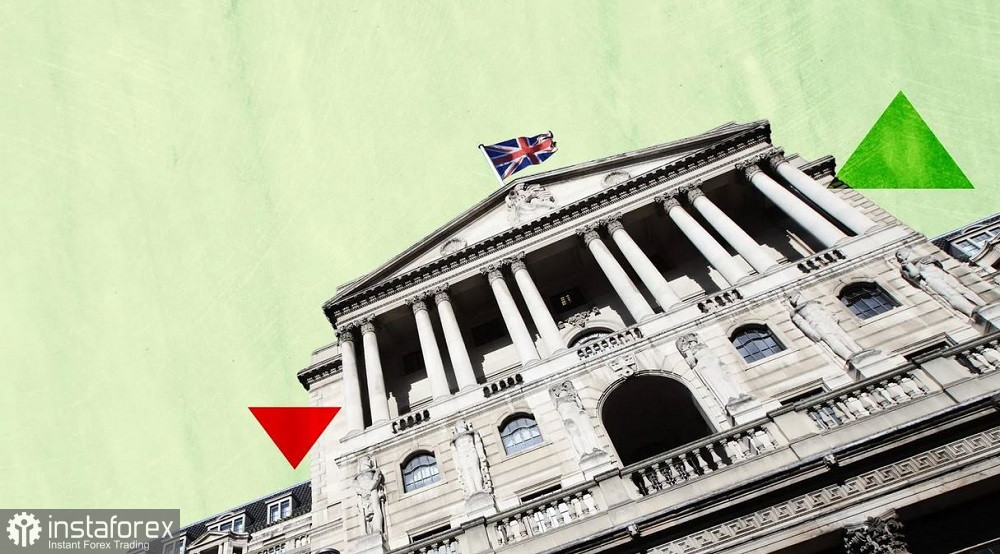The GBP/USD pair updated a one-and-a-half-week high yesterday, marking at the level of 1.2224. Not a remarkable achievement, but a fact nonetheless. It's important to understand that the upward rebound of GBP/USD is primarily driven by the weakening of the greenback, rather than the strengthening of the British currency. The Bank of England did not become an ally of the pound at the November meeting, although some signals had a hawkish nature.
The formal results of the November meeting of the Bank of England were predetermined from the beginning, considering the prior rhetoric of central bank officials. And, for the most part, the regulator fully met market expectations by keeping the parameters of monetary policy unchanged. However, I must emphasize that certain indirect signals did have a slight influence on the pound.

Firstly, the voting results of the committee members favored the British currency. The decision to keep the rate at the same level was supported by six out of nine members of the central bank. Accordingly, three members voted for a 25 basis point rate increase. According to the overall estimates, the status quo was expected to be supported by seven (and, by some assessments, even eight) committee members. Although the "hawkish wing" is clearly in the minority, the mere fact of its presence provided some support for the British currency.
Secondly, Bank of England Governor Andrew Bailey allowed for further tightening of monetary policy. According to his words, this step would be necessary in the event of "more sustainable inflationary pressure than expected at the moment." In this context, he stated that the bank's mandate is price stability, "not preventing a recession." Bailey also refuted rumors that the central bank intends to soften quantitative easing in the near future. He noted that it is "too early to even think about a rate cut."
Thirdly, following the November meeting, the central bank revised its inflation target. While previously, the regulator assumed that inflation would return to the 2% level by the second quarter of 2025, now, this time frame has been extended to the end of 2025. According to the updated forecasts, the consumer price index in the UK will slow down to 4.75% in the fourth quarter of this year, followed by a further decline to 4.5% and 3.75% in the first and second quarters of the next year, respectively. Bailey emphasized that recent events in the Middle East have created uncertainty, with the risk of rising energy prices and all the resulting consequences.
Well, that's about it. These are the main "hawkish" factors that allowed the British pound to stay afloat and take advantage of the general weakening of the dollar. All other statements/formulations by the English regulator indicated that the Bank of England's baseline scenario is to maintain the interest rate at the current level "for an extended period."
The phrase "the Bank of England should not maintain restrictive monetary policy for too long" should not be interpreted as a dovish signal since this formulation lacks specific time references. Bailey made it clear that the question of rate cuts will not be on the agenda in the near future, especially given the risks associated with the Middle East conflict.
As a result, the Bank of England did not "sink" the British currency at the November meeting, but it provided rather mediocre support. The main statements made were secondary, and the "hawkish" signals were too indirect or mediated. Therefore, the pound did not become an anchor for the GBP/USD pair, and this fact allowed buyers to take advantage of the weakness of the greenback.
The U.S. dollar, in turn, is influenced by several fundamental factors. Among the main reasons are the decline in Treasury yields (the yield on 10-year bonds has currently fallen to 4.664%, while at the beginning of the week it was at 4.93%), increased interest in risky assets (key Wall Street indices demonstrated impressive growth yesterday), and contradictory macroeconomic reports published in the United States. For example, weekly initial jobless claims rose to 217,000 (the highest level since early September), and unit labor costs fell by 0.8% QoQ. Meanwhile, the volume of factory orders increased by 2.8% in September on a monthly basis.
In response to the current fundamental backdrop, the U.S. dollar index declined to the 105 level (105.8 points), and the GBP/USD pair settled above the 1.2190 resistance level (the middle line of the Bollinger Bands indicator, coinciding with the Tenkan-sen and Kijun-sen lines on the D1 timeframe). The technical picture for the pair allows for a move towards the next price barrier located at the 1.2290 level, which corresponds to the upper Bollinger Bands line on the same timeframe.
 English
English 
 Русский
Русский Bahasa Indonesia
Bahasa Indonesia Bahasa Malay
Bahasa Malay ไทย
ไทย Español
Español Deutsch
Deutsch Български
Български Français
Français Tiếng Việt
Tiếng Việt 中文
中文 বাংলা
বাংলা हिन्दी
हिन्दी Čeština
Čeština Українська
Українська Română
Română

